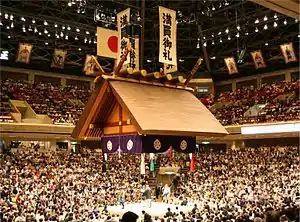Ryōgoku Kokugikan
Ryōgoku Kokugikan (両国国技館), also known as Ryōgoku Sumo Hall, is an indoor sporting arena located in the Yokoami neighborhood (bordering to the Ryōgoku neighborhood) of Sumida, one of the 23 wards of Tokyo in Japan, next to the Edo-Tokyo Museum. It is the third building built in Tokyo associated with the name kokugikan. The current building was opened in 1985 and has a capacity of 11,098 people.[2][1]
Ryōgoku Sumo Hall | |
 | |

| |
| Location | |
|---|---|
| Coordinates | 35°41′49″N 139°47′36″E |
| Public transit | JR East/Toei Subway: |
| Owner | Japan Sumo Association |
| Operator | Japan Sumo Association |
| Capacity | 11,098[1] |
| Opened | January, 1985[2] |
It is mainly used for sumo wrestling tournaments (honbasho) and hosts the Hatsu (new year) honbasho in January, the Natsu (summer) honbasho in May, and the Aki (autumn) honbasho in September. It also houses a museum about sumo.[3]
The venue is also used for other indoor events, such as boxing, pro wrestling, and music concerts.[4] In past years, it has hosted the finals of New Japan Pro Wrestling's annual G1 Climax tournament as well as the Sakura Genesis and King of Pro-Wrestling events and the WWE's The Beast in the East event in 2015. In 2017 it hosted Ferrari's 70th anniversary celebrations.[4] Paul McCartney performed a concert at the venue as part of his world tour "Freshen Up" on November 5, 2018.
History



The growing popularity of Sumo during the Meiji period led to the building of the original Kokugikan in Ryōgoku in 1909. The Japanese army appropriated the facility in World War II, and some tournaments were held outdoors at a baseball stadium. During the occupation of Japan, SCAP saw sumo as less threatening than other martial arts, and allowed a tournament there in November 1945. The occupation forces subsequently took over the area, however, and turned it partially into a skating rink. One more tournament was held in November 1946, but tournaments were thereafter held on the grounds of the Meiji Shrine until 1954. Tournaments were subsequently held in the Kuramae Kokugikan, which opened in 1954, until it was replaced by the current Ryōgoku Kokugikan in Yokoami in 1985.[5] It will host the boxing competition at the 2020 Summer Olympics.[6]
In other media
In the anime series Hajime no Ippo, some of the characters participate in boxing matches in the Ryōgoku Kokugikan.
In the manga and anime series Aah! Harimanada, the Ryōgoku Kokugikan is featured prominently and all the sumo tournaments are held there.
In the manga series Hinomaru Zumō, some of the tournaments are held at the Ryōgoku Kokugikan.
In the manga series Prison School, some of the characters attend a student sumo tournament in the Ryōgoku Kokugikan.
Transportation Links
The arena is served by the Ryōgoku Station with platforms to the south and east of the arena. The JR East Chūō-Sōbu Line platforms to the south are served by local trains while rapid trains bypass the platforms by going through a tunnel north of the platforms. The two main platforms are built as an island platform, with trains heading west to Tokyo and east to Chiba, while there is a third terminal platform that is only used on special event days. The Toei Subway Ōedo Line platforms lie in a north-south axis directly underneath Kiyosumi Street to the east of the arena. There are regular trains to Iidabashi and Tochomae from platform 1 and Daimon and Roppongi from platform 2.
Gallery

Sumo wrestlers of the second-highest juryō division prepare for a bout in the Ryōgoku Kokugikan. 

The dohyō-iri of the top makuuchi division wrestlers, prior to the start of competition. 
The suspended Shinto-style roof, or tsuriyane, over the dohyō. Above it are displayed the "man'in onrei" banners thanking the audience for a sold-out house. .jpg.webp)
References
- "ホーム > 国技館のご案内 > 概要". Nihon Sumo Kyokai. Retrieved 7 May 2017.
- Shapiro, David (1995). Sumo: A Pocket Guide. Tokyo: Charles E. Tuttle Company, Inc. p. 44. ISBN 978-1-4629-0484-6. Retrieved 7 May 2017.
- Japan, An Illustrated Encyclopedia (Hardcover). Tokyo, Japan: Kodansha. 1993. p. 817. ISBN 4-06-205938-X.
- Gunning, John (12 February 2020). "Legendary Ryogoku Kokugikan has adapted to modern needs". The Japan Times. Retrieved 12 February 2020.
- With God on Their Side: Sport in the Service of Religion (Hardcover). London and New York: Routeledge. 2002. pp. 151–2. ISBN 0-415-25960-6.
- "Venue Plan". Tokyo 2020 Bid Committee. Archived from the original on 27 July 2013. Retrieved 11 September 2013.
External links
| Wikimedia Commons has media related to Ryogoku Kokugikan. |
